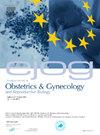Progressive changes in delivery outcomes following the launch of round-the-clock labour epidural analgesia at an institution: A retrospective cohort study
IF 2.1
4区 医学
Q2 OBSTETRICS & GYNECOLOGY
European journal of obstetrics, gynecology, and reproductive biology
Pub Date : 2025-01-31
DOI:10.1016/j.ejogrb.2025.01.041
引用次数: 0
Abstract
Background
Emergency caesarean section is associated with maternal and foetal complications, potentially exacerbated by general anaesthesia use.
Objective
To determine whether labour epidural analgesia use affects caesarean section incidence.
Study design
This retrospective single-centre cohort study involved women in labour (n = 11,792) between 1 January 2015 and 31 December 2021. The primary outcome was caesarean section incidence, determined from electronic medical records; secondary outcome was caesarean section incidence change over time.
Results
Of 5849 deliveries from 1 August 2018, when round-the-clock labour epidural analgesia became available, until 31 December 2021, 1,433 (24.5 %) involved labour epidural analgesia. Of these, 203 (14.2 %) involved unintended caesarean section, less than that in the non-labour epidural analgesia group (22.2 %) (hazard ratio: 0.47; 95 % confidence interval [CI]: 0.41–0.55, p < 0.001). Sensitivity analysis, assuming 50 % of non-labour epidural analgesia cases should have had used labour epidural analgesia, yielded a hazard ratio of 0.65 (95 %CI: 0.57–0.75, p < 0.001). Propensity-score matching adjusted for possible confounders. Temporal changes in caesarean section incidence were analysed between 1 August 2018 and 31 October 2021. This passage of time explained the reduction in values for the difference-in-differences analysis by 20.5 % (95 %CI: 5.5–35.6, p = 0.007). Interrupted time series analysis revealed caesarean section incidence increased with time after round-the-clock labour epidural analgesia became available in the non-labour epidural analgesia group (p = 0.01).
Conclusions
Round-the-clock labour epidural analgesia use is associated with decreased caesarean section incidence, partly due to optimisation of eligibility criteria. Labour epidural analgesia use should be expanded to aid vaginal delivery and improve maternal well-being.
求助全文
约1分钟内获得全文
求助全文
来源期刊
CiteScore
4.60
自引率
3.80%
发文量
898
审稿时长
8.3 weeks
期刊介绍:
The European Journal of Obstetrics & Gynecology and Reproductive Biology is the leading general clinical journal covering the continent. It publishes peer reviewed original research articles, as well as a wide range of news, book reviews, biographical, historical and educational articles and a lively correspondence section. Fields covered include obstetrics, prenatal diagnosis, maternal-fetal medicine, perinatology, general gynecology, gynecologic oncology, uro-gynecology, reproductive medicine, infertility, reproductive endocrinology, sexual medicine and reproductive ethics. The European Journal of Obstetrics & Gynecology and Reproductive Biology provides a forum for scientific and clinical professional communication in obstetrics and gynecology throughout Europe and the world.

 求助内容:
求助内容: 应助结果提醒方式:
应助结果提醒方式:


